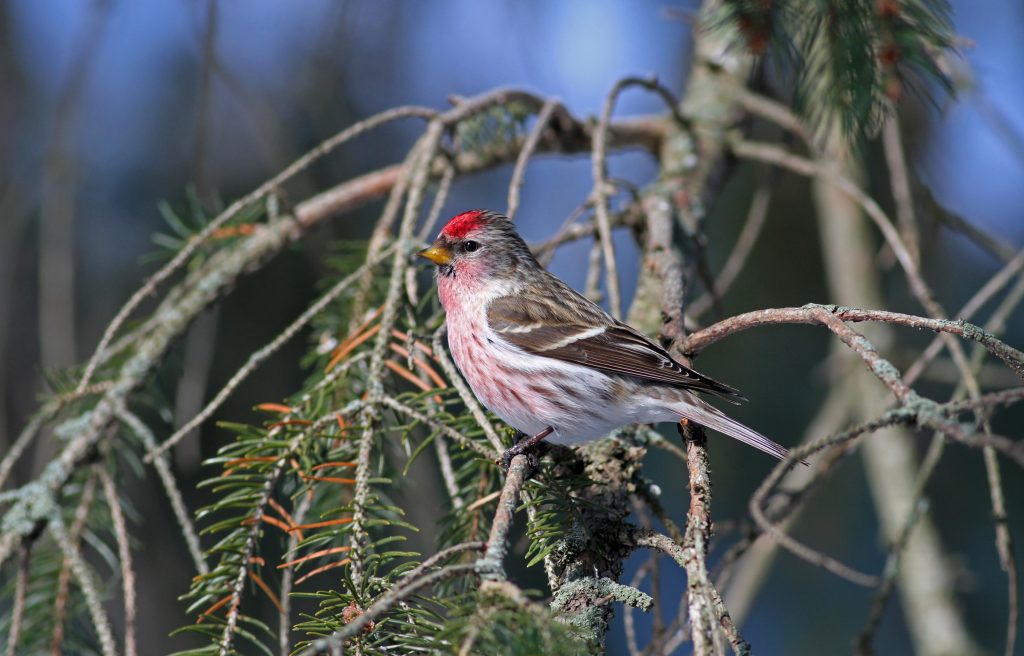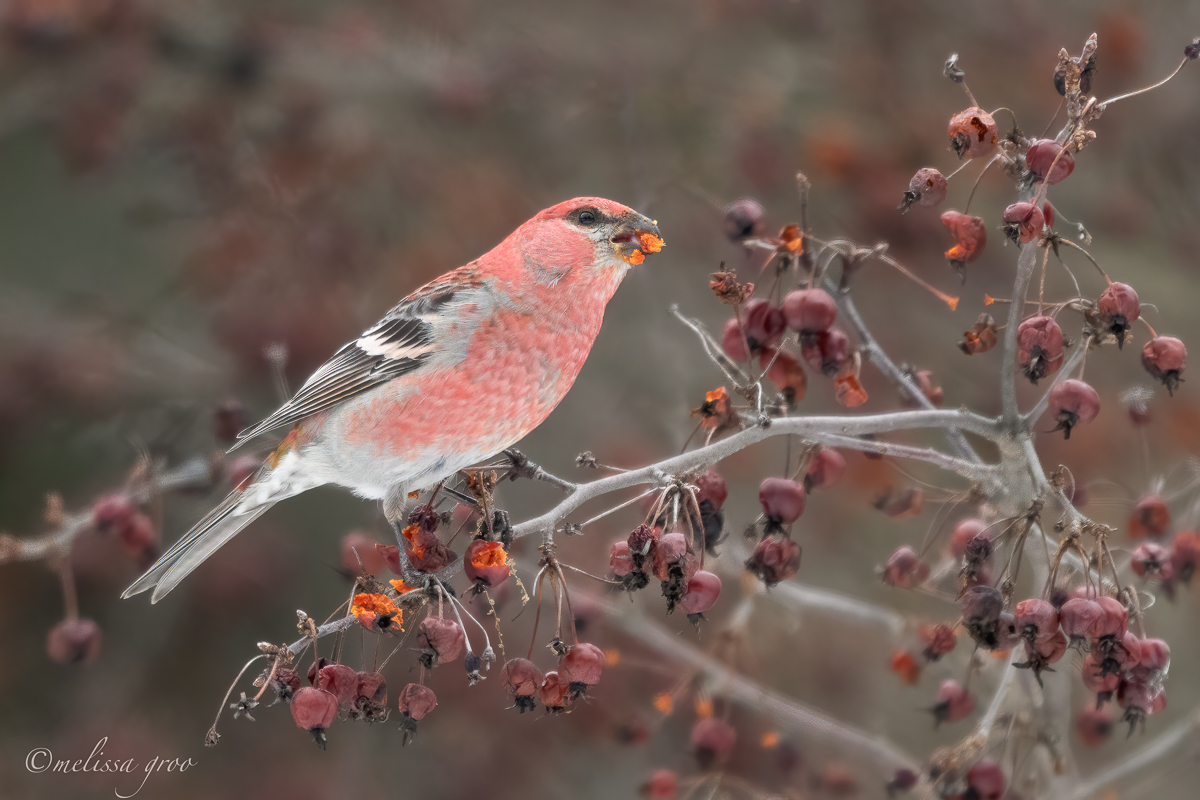Fall 2020 Superflight in Review: Pine Grosbeak, Evening Grosbeak, and Common Redpoll
by Joe Gyekis
When there’s a superflight of finches, three of the most exciting feeder birds that can arrive from the north are Pine Grosbeak, Evening Grosbeak, and Common Redpoll. Animated maps are presented below to illustrate the extent and timing of their irruptions in the fall 2020 to spring 2021 field season using eBird data from across North America.

Pine Grosbeaks are top tier birds–the most desirable feeder birds for many eastern birders with very high hopes. The cachet of this circumpolar species comes from the combination of their extreme rarity in the temperate regions, their splendid plumage, and their ringing cheery voices. The 2020 Winter Finch Forecast noted that there were some areas in Canada with poor fruit supplies that Pine Grosbeaks relied upon, but figured the remaining areas that did have fruit would be enough to hold Pine Grosbeaks in the north except for a small number of wanderers. As it turned out, an unusually large movement of Pine Grosbeaks appeared in the Great Lakes, New England and eastern half of New York areas in November of 2020 and stayed throughout the winter. People further south wished that birds would continue pushing down the continent through the winter, but very few continued south of the Atlantic Northern Forest and Great Lakes/St. Lawrence regions.
The animated map below shows the year on year change in proportion of complete eBird checklists reporting Pine Grosbeaks for each Bird Conservation Region for each month over the irruption cycle. Areas that show deep red have a big increase in the percentage of Pine Grosbeaks reported in fall 2020 compared to fall 2019 (or spring 2021 minus spring 2020). Blue areas had a lower percentage of Pine Grosbeaks this cycle (especially noteworthy in November and December in the Boreal Softwood Shield region–apparently indicating an area vacated in 2020 that had been more of the winter range in 2019).
Evening Grosbeaks also had a banner year. Like the irruptions of the old days, they made it much further south than the Pine Grosbeaks. Many areas that in recent decades have reported only a few birds were presented with big flocks during the 2020-21 irruption.

Up north, at Tadoussac, the whole fall season count for 2020 was 3117, pretty similar to the total of 2624 that was counted in the fall of 2018. However, further south, it’s more obvious how spectacular this irruption was compared to 2018. Consider the Cape May Higbee Beach morning flight count, which was mightily pleased to have found 6 of them by the end of their count season in 2018 (few had been seen at Cape May for about 5 years before that). However, in 2020, the count total was 177, including 57 in a single morning, by far the biggest year for the species at Cape May since the 1990s. Cape May’s hawkwatch site had a similar pattern, going from 9 in 2018 to 350(!) in 2020. A few made it as far south as Florida, but aside from those very thin scatters, but as the map shows, it was mainly the Appalachian region that hosted a respectable winter population with several 100s of birds making it to North Carolina. In central Pennsylvania where I live, they were spotty but findable. My mom had her feeders down because of the bears, but she found one perched up in a tree calling to add to our yard list–a joy shared by many this year.
Common Redpolls, and a smattering of Hoaries, irrupted as well, contributing to the feeling of the superflight in the east. Some got into the southern states, although they were only common as far south as the Great Lakes region. The tremendous increase over past years is visible in the animated map below, where the surge from October through March in the northern United States is quite bright. Most places that had 100 or so Commons had a good chance of finding a Hoary picking through the mix, although the complex spectrum of intermediate birds made it so that some candidates probably slipped through the “cautious valley” between the obviously flammea and the obviously Hoary. While a few birds made it as far south as Cape May, it was only a few. On the other hand, at the northeastern edge of the St. Lawrence River valley, thousands were counted at Tadoussac. The 9312 counted that fall season seemed tremendous, especially compared to the total of 3942 from the fall 2018 irruption, but after their recent count, a mere nine thousand suddenly seems modest.

During the fall 2021 count at Tadoussac, Jessé Roy-Drainville has counted over a quarter million redpolls pushing south down the St Lawrence seaway coast. On half the November count days this year, they had more redpolls than the entire season total last year! Last year seemed like a big count, and many redpolls made it south of the normal winter range. However, in fall 2021, these redpolls seem to be accumulating in Canadian forests and not making it into the United States except for the most northern forested regions. Large redpoll numbers have already been reported in the western Great Lakes and the intermountain west and it’ll be interesting to see if the mind-blowingly huge count at Tadoussac brings a significant southward push into the northeast when the natural food conditions in the north are good.
The 2020 and 2021 Winter Finch Forecasts did a nice job of sorting this out and accurately predicting the southward pushes based on the Canadian mast crops. However, it still seems like there is a lot of mystery in redpoll population trends, since I don’t know if anyone was predicting such an enormous population increase this year. It will be very interesting to see what fall 2022 brings, and for more on that see this year’s winter finch forecast: https://finchnetwork.org/winter-finch-forecast-2021-2022-by-tyler-hoar
Cover Photo Credit Melissa Groo
For more on last year’s irruption in review: https://finchnetwork.org/fall-2020-irruption-in-review-the-three-usual-suspects-have-a-big-year
FiRN is a nonprofit, and has been granted 501c3 status. FiRN is committed to researching and protecting these birds and threatened finch species like the Evening Grosbeak, a species that has declined 92% since 1970. We are actively in the process of fundraising around an Evening Grosbeak Road to Recovery plan in addition to a student research project, so please think about supporting our efforts and making a small donation at the donate link below.
If you’re interested in keeping up with updates from the Finch Research Network, please consider subscribing to our email list here: https://finchnetwork.org/subscribe

